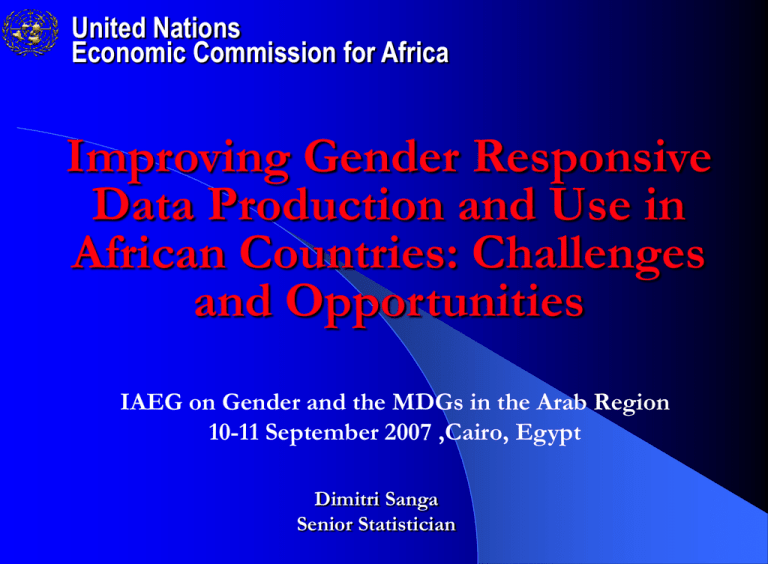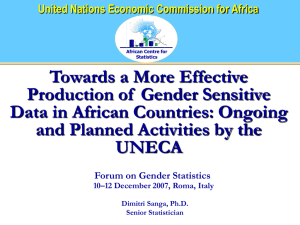
United Nations
Economic Commission for Africa
Improving Gender Responsive
Data Production and Use in
African Countries: Challenges
and Opportunities
IAEG on Gender and the MDGs in the Arab Region
10-11 September 2007 ,Cairo, Egypt
Dimitri Sanga
Senior Statistician
Outline
Background
Countries’ Development Agendas
Why are Gender Statistics Critical?
Gender Statistics Challenges in Africa
ECA’s Response to Gender Statistics
Challenges
Future Developments
Conclusions
2
Background
3
Countries’ Development Agendas
National, regional, and international initiatives
aimed at promoting economic and social
development in African countries
NEPAD adopted as a reference framework for the
Africa’s development (2000)
The Millennium Declaration (2000, MDGs)
The Poverty Reduction Strategies (PRSs)
All these initiatives recognize that women and
men face different socio-economic challenges
4
Why are Gender Statistics Critical?
Thus, the importance of gender statistics in
the implementation, monitoring, and
evaluation of these initiatives and others
Gender statistics:
Allow for unbiased evidence-based policy
formulation and decision making
Address issues of inequalities and empowerment
of women
Raise consciousness, persuade policy makers and
other stakeholders to take into account the gender
dimension in policy and decision making
5
Gender Statistics Challenges in Africa
Inadequate advocacy for gender statistics
Lack of strong commitment to gender statistics
development by NSS. Hence, lack of mainstreaming
of gender statistics in statistical programmes and
activities
Inadequacy between statistical programs and national
data priorities
Low profile of statistical units in line ministries where
they exist
Lack of technical skills and adequate statistical
infrastructure (sampling frames, classifications,
concepts, definitions and methods)
Inadequate sex disaggregated data management
(archiving, analysis, and dissemination)
6
Particular Difficult Areas
Data on gender based violence are difficult to
obtain:
Within the family: intimate partner violence,
harmful traditional practices …
Within the community: femicide, sexual
harassment, trafficking in women …
Other: Violence against women in armed conflicts,
sexual slavery…
Data on women’s contribution to the economy:
Unqualified domestic work
Inadequate data on informal sector
7
ECA’s Response to Gender
Statistics Challenges
8
Selected Initiatives
ECA’s initiatives aimed at addressing gender
statistics challenges include:
The development of the African Gender and
Development Index (AGDI)
Engendering the P&R on population and housing
censuses
Setting up an African gender statistics network
Engendering agricultural and trade statistics
Dissemination of methodologies and tools for the
development of gender-disaggregated data
Advocating and initiating the undertaking of Time
Use surveys
9
The AGDI
A composite index made of two components:
The Gender Status Index (GSI): captures quantitatively
measurable issues related to gender equality
The African Women’s Progress Scoreboard (AWPS)
complements the GSI by measuring government policy
performance regarding transformation of social institutions
that affects women’s advancement and empowerment
Some desirable features of the AGDI?
Making use of data sets that are nationally available
Incorporation of qualitative issues
Monitoring mechanism to assess performance in
implementing the various instruments African countries
have ratified (CEDAW, BPFA, ACHPR, etc.)
12 African countries completed the process so far
10
Some Components of the GSI
Block
Component
Sub component
Indicator
Primary enrolment rate
Enrolment rate
Secondary enrolment rate
Tertiary enrolment rate
Education
Social power
“capabilities
”
Dropout
Literacy
Child health
Health
Primary dropout ratio
Secondary dropout ratio
Ability to read and write
Primary school
completed
Stunting under 3
Underweight under 3
Mortality under 5
Life expectancy at birth
New HIV infection
Time spent out of work
11
%
Budget
Institutional
mechanism
Targets
Development
of a plan
Policy
commitment
Law
Reporting
Ratification
Some Components of the AWPS
WOMEN’S RIGHTS
Ratification without
reservation
CEDAW
Optional protocol
Art 2
Art 16
African Charter of Human and People’s RightsWomen’s Rights Protocol- Harmful Practices
Beijing Platform for Action
SOCIAL
Domestic violence
Violence against
women
Rape
Sexual harassment
Traffic in women
African Charter on the rights of the Child art
XXVII
2001 Abuja Declaration on HIV/AIDS and
women
12
The AGDI: Lessons Learned
Lessons learned from field trials:
Problems with data accessibility even where
available for confidentiality reasons
Inadequate equipment or training and
insufficient resources
Tapping the national information sources of
the countries proved to open a rich mine of
data and stimulate a consensus binding
process
Use of national data allowed access to the
most recent data available
13
Engendering the P&R on
Population and Housing Censuses
Review and recommendations on how to take
into account gender perspectives in census
undertaking in the framework of the 2010 RPHC
Built on:
On-going work on the AGDI and its sectoral components
Tools on gender statistics and time use developed by the
UNSD and the UNECA
On-going work on the African Supplement to the P&R on
PHC undertaken by the UNECA
Potential activities
Review various stages of censuses undertaking with a view to
take into account gender issues
Draft an African Gender Supplement to P&R on PHC
14
African Gender Statistics Network
To provide a framework for knowledge sharing,
peer learning and networking between all
stakeholders dealing with gender statistics issues
The Network would:
Advocate for the integration of gender equality
concerns into the policy agenda and the development
of standards, frameworks and guidelines (P&R on
PHC, RRSF, NSDSs…)
Contributions to the preparation and organization of
various consultative meetings from a gender
perspective
Participate in other meetings of statistical bodies such
as ABSA, StatCom-Africa
Dissemination of information on gender statistics
15
Engendering Agricultural and Trade
Statistics
Deepening the work on the AGDI in trade and
agriculture. Why these sectors?
Most African economies rely heavily on agricultural
production
Women: majority of the agricultural workforce while
their access to land, seeds, water… is still limited
Agriculture: An essential part of intra-African and
international trade
Understanding the multidimensional aspects of
feminized poverty as they relate to food security,
access to resources, services…
Activities:
Identification of issues related to gender, trade, and
agriculture, current indicators used in these two
areas, gender gaps in available statistics
Development of the sectoral indexes
16
Dissemination of Methodologies
and Tools for the Development of
Gender Statistics
Guide for mainstreaming gender perspectives
and household production into national
statistics, budgets and policies in Africa
Improve the skills of statisticians, national
accountants and policy analysts, on how to
engender national planning instruments
Disseminate the methodologies developed by
ECA for the collection of gender-responsive
data
17
Time Use Surveys
Time Use Surveys are useful statistical
tools:
Generating data on how individuals spend
their time
Producing sex disaggregated statistics on
productive activities by households and
estimating the value of unpaid work
Building national gender satellite accounts of
household production
Defining macro-economic policies that take
into account women’s unpaid work
Experiencing TUS in Djibouti underway
18
Future Developments
Extend the AGDI to more African
countries
Advocating for the creation of gender
statistics units in NSOs
Putting in place a regional gender statistics
programme
Considering the creation of an African
gender statistics City Group under the
umbrella of the Statistical Commission for
Africa
19
Conclusions
Mainstreaming gender within NSS is of
paramount importance
Statistics on individuals should be collected,
collated, analysed, and presented disaggregated
by sex
Identifying gender issues and ensuring that data
addressing these (gender-responsive statistics)
are collected and made available
NSOs need to be provided with adequate
resources to coordinate and generate relevant
sex disaggregated data and make them
accessible to the public at large
Reinforcing the capacity for the production and
use of gender responsive data is crucial in the
formulation of comprehensive gender sensitive
policies that benefit the entire society
20
Thank you!
21












